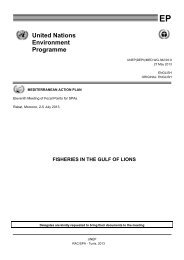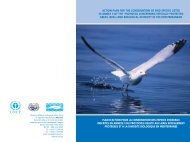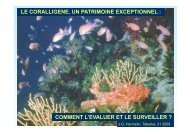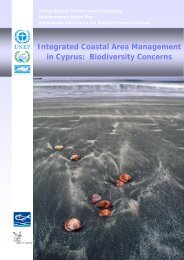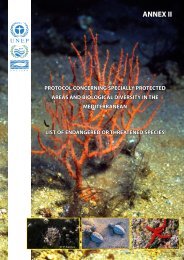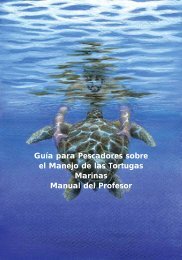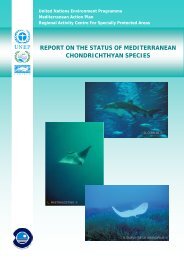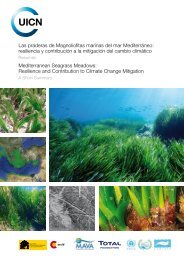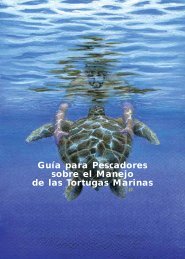Proceedings of the Second Mediterranean Symposium on Marine
Proceedings of the Second Mediterranean Symposium on Marine
Proceedings of the Second Mediterranean Symposium on Marine
Create successful ePaper yourself
Turn your PDF publications into a flip-book with our unique Google optimized e-Paper software.
PROCEEDINGS OF THE SECOND MEDITERRANEAN SYMPOSIUM ON MARINE VEGETATION (ATHENS, 12-13 DECEMBER 2003)<br />
68<br />
In c<strong>on</strong>clusi<strong>on</strong>, from this study it resulted a noticeable similarity am<strong>on</strong>g <str<strong>on</strong>g>the</str<strong>on</strong>g> six<br />
<str<strong>on</strong>g>Mediterranean</str<strong>on</strong>g> areas here c<strong>on</strong>sidered from both floristic and phytogeographic point <str<strong>on</strong>g>of</str<strong>on</strong>g><br />
views with <str<strong>on</strong>g>the</str<strong>on</strong>g> <strong>on</strong>ly excepti<strong>on</strong>, as above menti<strong>on</strong>ed, <str<strong>on</strong>g>of</str<strong>on</strong>g> <str<strong>on</strong>g>the</str<strong>on</strong>g> LEL area. Moreover, it should<br />
be pointed out that <str<strong>on</strong>g>the</str<strong>on</strong>g> benthic macroalgal flora <str<strong>on</strong>g>of</str<strong>on</strong>g> Italy is <str<strong>on</strong>g>the</str<strong>on</strong>g> richest in species. That is<br />
due, besides <str<strong>on</strong>g>the</str<strong>on</strong>g> high number <str<strong>on</strong>g>of</str<strong>on</strong>g> phycological studies carried out al<strong>on</strong>g its coasts<br />
(especially in <str<strong>on</strong>g>the</str<strong>on</strong>g> last years), also because Italy has a noticeable extensi<strong>on</strong> <str<strong>on</strong>g>of</str<strong>on</strong>g> rocky shores<br />
that are, moreover, washed by three seas: Tyrrhenian, I<strong>on</strong>ian and Adriatic.<br />
Finally, it should be pointed out that, even though algal lists taken into c<strong>on</strong>siderati<strong>on</strong> are<br />
based <strong>on</strong> references since 1950 in order to represent as well as possible <str<strong>on</strong>g>the</str<strong>on</strong>g> present<br />
compositi<strong>on</strong>, for some areas <str<strong>on</strong>g>the</str<strong>on</strong>g>y can be already c<strong>on</strong>sidered as "historical". In fact, very<br />
recent studies have shown noticeable changes in <str<strong>on</strong>g>the</str<strong>on</strong>g> floristic compositi<strong>on</strong> in some areas<br />
occurred in <str<strong>on</strong>g>the</str<strong>on</strong>g> last decades : for example, at <str<strong>on</strong>g>the</str<strong>on</strong>g> Tremiti Islands (Adriatic Sea, Italy), from<br />
a floristic study carried out in <str<strong>on</strong>g>the</str<strong>on</strong>g> year 1997 and published in 2000 (Cormaci et al.<br />
2000) it resulted that <str<strong>on</strong>g>of</str<strong>on</strong>g> 275 species reported in literature between <str<strong>on</strong>g>the</str<strong>on</strong>g> late '60s and<br />
early '70s, 108 species (about 40% <str<strong>on</strong>g>of</str<strong>on</strong>g> that flora) were not found. C<strong>on</strong>versely, 153<br />
species (about 47% <str<strong>on</strong>g>of</str<strong>on</strong>g> <str<strong>on</strong>g>the</str<strong>on</strong>g> present flora) were newly reported.<br />
At Maddalena Peninsula (near Syracuse, Italy), from a study by Marino et al. (1999) it<br />
resulted that <str<strong>on</strong>g>of</str<strong>on</strong>g> 305 macroalgal species reported in literature up to 1980, 70 species<br />
(about 23% <str<strong>on</strong>g>of</str<strong>on</strong>g> that flora) were not found. C<strong>on</strong>versely, 164 species (about 41% <str<strong>on</strong>g>of</str<strong>on</strong>g> <str<strong>on</strong>g>the</str<strong>on</strong>g><br />
present flora) were newly reported.<br />
At <str<strong>on</strong>g>the</str<strong>on</strong>g> Ciclopi Islands (near Catania, Italy), from an unpublished study carried out in <str<strong>on</strong>g>the</str<strong>on</strong>g><br />
year 2000 (Serio, pers<strong>on</strong>al communicati<strong>on</strong>), it resulted that <str<strong>on</strong>g>of</str<strong>on</strong>g> 364 species reported in<br />
literature between 1969 and 1989, 135 species (37% <str<strong>on</strong>g>of</str<strong>on</strong>g> that flora) were not found<br />
while 46 species (about 17% <str<strong>on</strong>g>of</str<strong>on</strong>g> <str<strong>on</strong>g>the</str<strong>on</strong>g> present flora) were newly reported. It is probable<br />
that similar changes, that are verifying in different areas <str<strong>on</strong>g>of</str<strong>on</strong>g> <str<strong>on</strong>g>the</str<strong>on</strong>g> <str<strong>on</strong>g>Mediterranean</str<strong>on</strong>g> Sea, are<br />
due to different factors like <str<strong>on</strong>g>the</str<strong>on</strong>g> increasing <str<strong>on</strong>g>of</str<strong>on</strong>g> <str<strong>on</strong>g>the</str<strong>on</strong>g> average temperature <str<strong>on</strong>g>of</str<strong>on</strong>g> <str<strong>on</strong>g>the</str<strong>on</strong>g> seawater,<br />
<str<strong>on</strong>g>the</str<strong>on</strong>g> increasing <str<strong>on</strong>g>of</str<strong>on</strong>g> discharge <str<strong>on</strong>g>of</str<strong>on</strong>g> both chemical pollutant and/or <str<strong>on</strong>g>of</str<strong>on</strong>g> inert material causing a<br />
noticeable increasing <str<strong>on</strong>g>of</str<strong>on</strong>g> water turbidity, etc.<br />
Therefore, <str<strong>on</strong>g>the</str<strong>on</strong>g> drawing <str<strong>on</strong>g>of</str<strong>on</strong>g> checklists, like those <str<strong>on</strong>g>of</str<strong>on</strong>g> Fucophyceae, Chlorophyceae, Ceramiales<br />
<str<strong>on</strong>g>of</str<strong>on</strong>g> <str<strong>on</strong>g>the</str<strong>on</strong>g> <str<strong>on</strong>g>Mediterranean</str<strong>on</strong>g> Sea, and/or floras, like that <str<strong>on</strong>g>of</str<strong>on</strong>g> Italy here discussed, assume, in our<br />
opini<strong>on</strong>, a particular value. In fact, <strong>on</strong> <strong>on</strong>e hand <str<strong>on</strong>g>the</str<strong>on</strong>g>y testify which species were present in<br />
a certain historical period in different areas <str<strong>on</strong>g>of</str<strong>on</strong>g> <str<strong>on</strong>g>the</str<strong>on</strong>g> <str<strong>on</strong>g>Mediterranean</str<strong>on</strong>g> Sea, <strong>on</strong> <str<strong>on</strong>g>the</str<strong>on</strong>g> o<str<strong>on</strong>g>the</str<strong>on</strong>g>r <str<strong>on</strong>g>the</str<strong>on</strong>g>y<br />
represent a starting point letting to check possible changes as <str<strong>on</strong>g>the</str<strong>on</strong>g>y happen.<br />
Note<br />
Paper and annexes updated from <str<strong>on</strong>g>the</str<strong>on</strong>g> original reprint:<br />
Furnari G., Giacc<strong>on</strong>e G. & Cormaci M. (2003) – The benthic macroalgal flora <str<strong>on</strong>g>of</str<strong>on</strong>g> Italy: Floristic and geobotanic<br />
c<strong>on</strong>siderati<strong>on</strong>s. Bocc<strong>on</strong>ea 16(1): 225-243.




